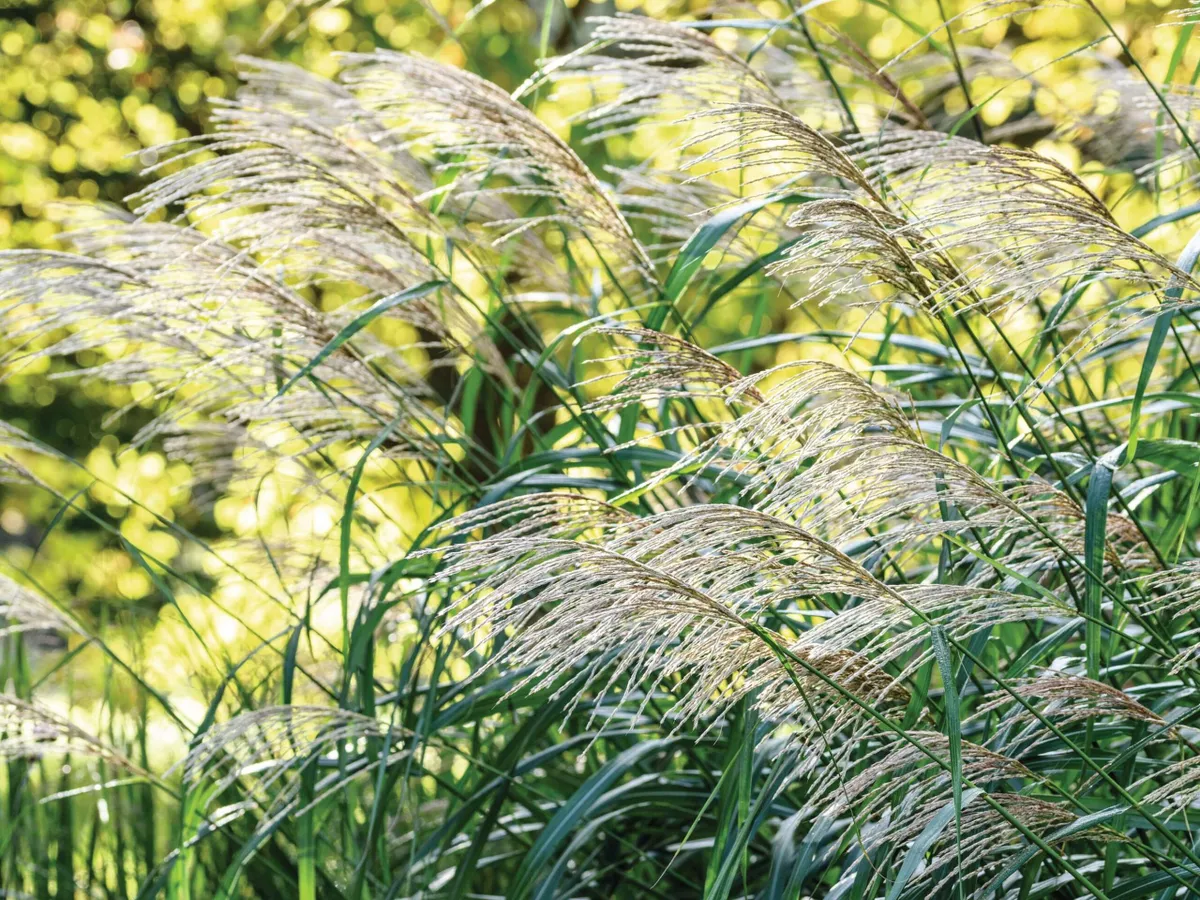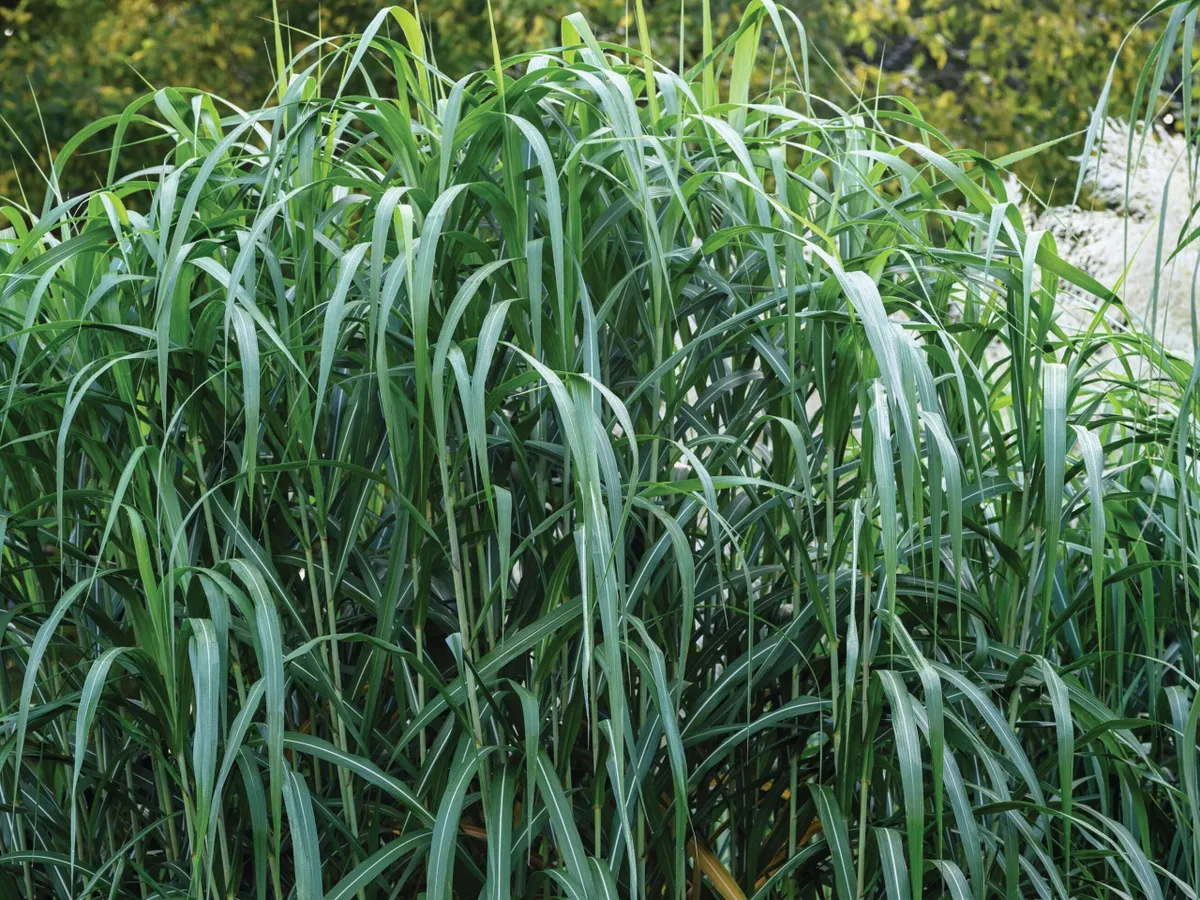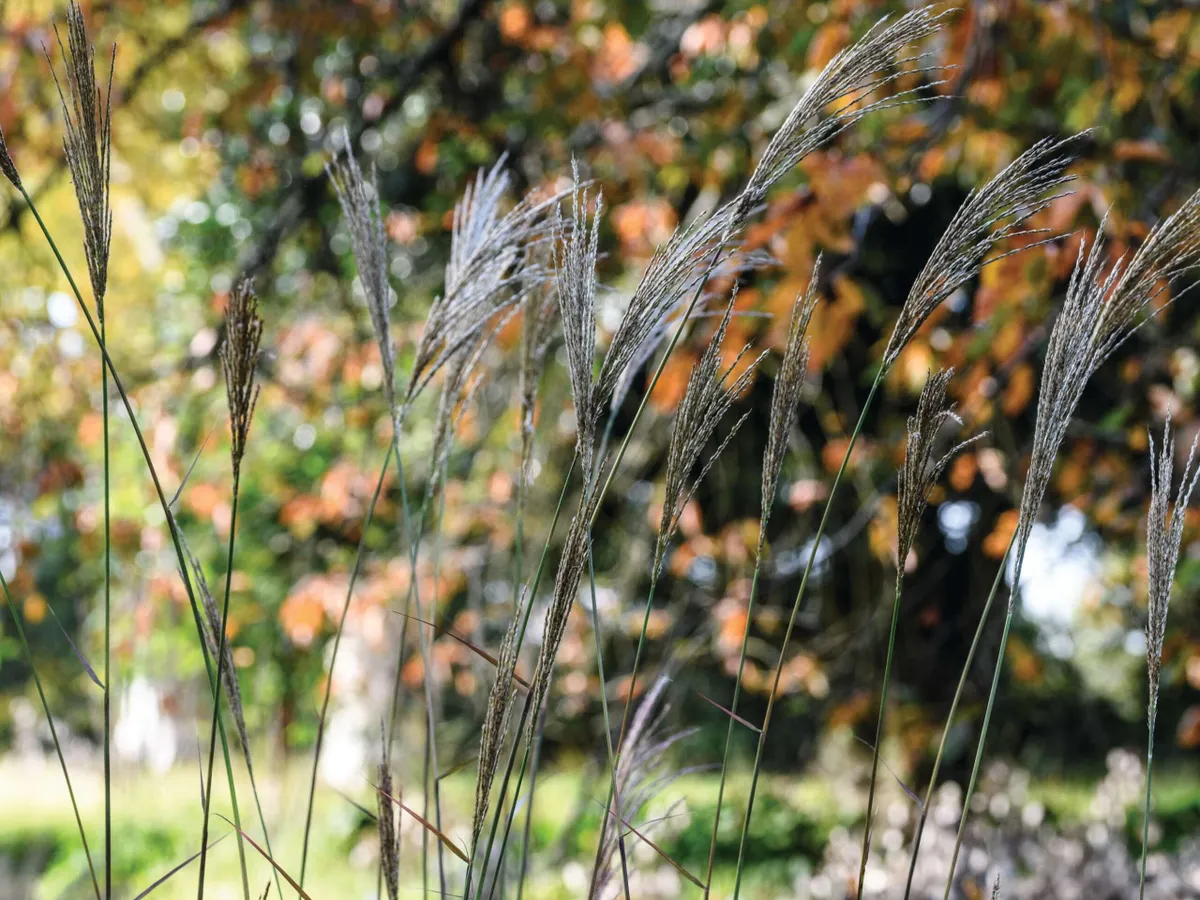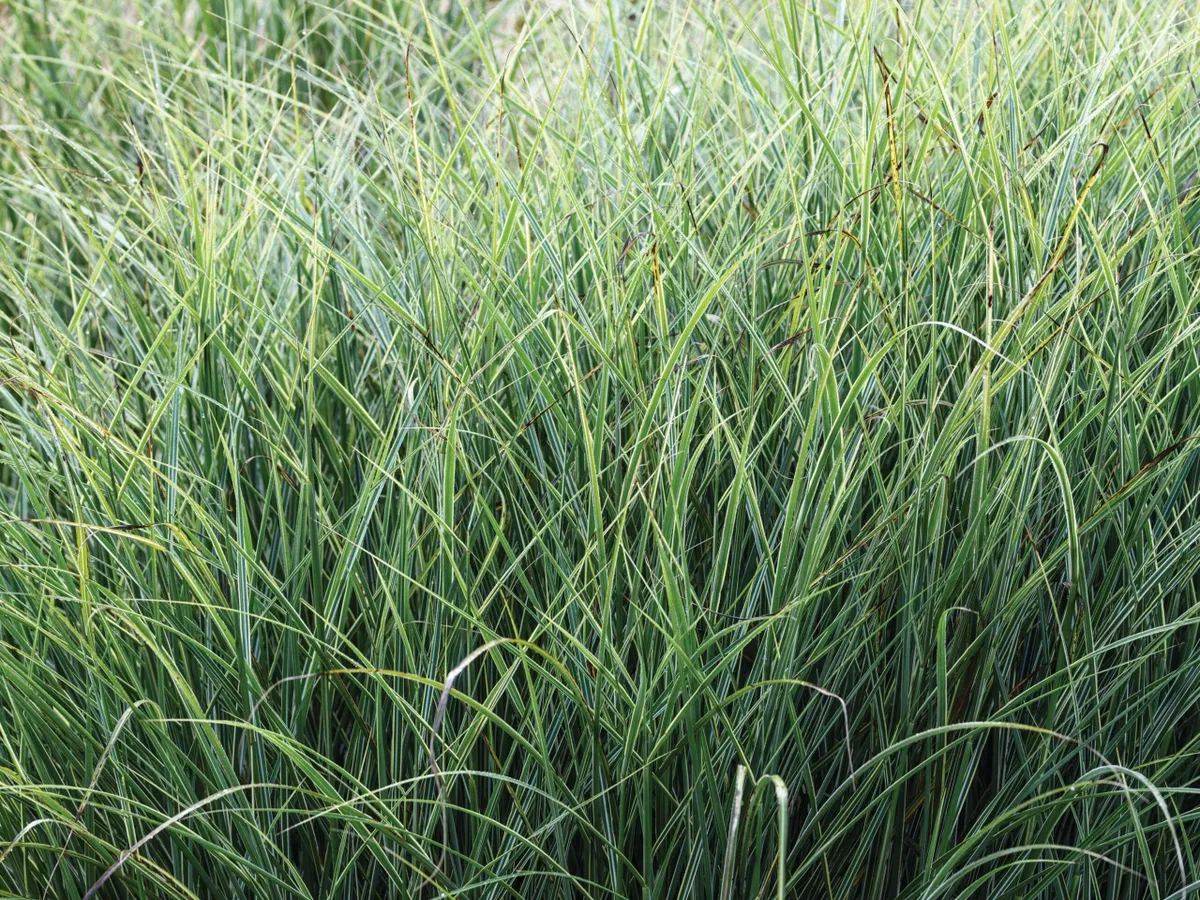Grown primarily for their masses of highsummer flowers, Miscanthus have been present in our gardens for a very long time. Victorian gardeners, for example, would use variegated forms such as Miscanthus sinensis ‘Zebrinus’ as ‘dot’ plants within their complex bedding schemes. Although this remains an excellent garden cultivar today, with its yellow, cross-banded foliage and occasional red flowers, the emphasis on Miscanthus in our gardens has since largely moved from foliage to flower.
Jump to
Like many other warm-season grasses, such as Pennisetum and Panicum, the combination of fast growth, fresh flower and numerous, subtle, autumnal variations to both foliage and flower allow Miscanthus to be effective in our gardens for a large part of the year.
Commonly knows as silver grass and eulalia grass, Miscanthus are tall, deciduous, generally upright, warm-season grasses. This simply means that in our climate they wake up comparatively late in the spring but then have the capacity, temperature permitting, to grow at a fast pace. Most flower initially around June to July, although – given the late springs we have recently been experiencing – flowering can be some weeks later.

How to grow Miscanthus
When to cut back Miscanthus
All Miscanthus are deciduous, with the dried stems and flowers of most standing more or less intact over winter. As winter draws to a close, the stems should be cut down to the base and either taken away and composted or kept in situ to act as a home-produced mulch. If left on the surface, cut the stems into lengths of around 20-30cm for a more effective and pleasing cover.
Timing depends a little on geographical area and weather, but ideally any time from February onwards.
The Chelsea Chop is a useful technique to reduce the height of a plant that might otherwise get too tall for its position.
Simply cutting the new foliage down to the base in May reduces the time left for a Miscanthus to grow before it flowers and so shortens its overall height.
Where to plant Miscanthus
Like all tall, flowering grasses, Miscanthus put on a great deal of growth in spring and require the energy derived from direct sunlight to fuel this process. Consequently, they need an open, sunny position in order to grow and flower successfully in the long term.
Miscanthus will cope with a variety of soils, from sand to quite heavy clay. Wet winter soil can be an issue, especially in the short term, as the young grasses may simply rot before they have a chance to establish an adequate root system.
When to plant Miscanthus
Planting can be done at any time of year that the soil is ready to receive the plants. For winter-wet soils it may be best to plant in the spring, while for summer drought-prone areas, autumn might be the optimum time.
How to care for Miscanthus
A surface mulch after planting is good practice as it will be useful for controlling weeds and helping to conserve essential soil moisture. Any organic material will do, including compost, bark, stable manure or commercially available mulch products.
Unless the soil is extremely poor, little additional feeding is required, especially if an organic mulch is being used. If an additional feed is felt to be necessary, any general balanced fertiliser should be fine.
Miscanthus are long-lived grasses that may not need any additional attention for many years. In some soils, the central section may gradually die away or otherwise fail to perform.
The best Miscanthus to grow
Miscanthus sinensis ‘Malepartus’

An old established selection and one of the best for garden use for its upright nature and wide green leaves, topped with purplish-red flowers in summer before its fabulous autumnal performance. Height and spread: 2.1m x 1.2m.
Miscanthus nepalensis

Unfading golden flowers produced on gently splaying stems arising from basal clumps of green foliage typify this species. Less hardy than other Miscanthus, requiring a sunny, well-drained and sheltered spot. Comes true from seed. 1.5m x 1m.
Miscanthus sinensis ‘Starlight’

A compact selection from the ‘Yaku Dwarf’ group and chosen for its rounded outline, relatively narrow foliage and extremely free-flowering nature. Excellent as a low screen. Initially slow growing. 1.2m x 1m.
Miscanthus sinensis ‘Roland’

Relatively large, almost hand-like, soft, silvery-pink flowers are produced during high summer at the top of tall, airy, slightly crinkled stems. One of the tallest in flower with comparatively large, wide leaves. 2.7m x 1m.
Miscanthus x giganteus

About the tallest grass to be grown in the UK, this giant, with its pendulous, dark-green leaves with pale, silvery midribs, is unrivalled as an informal screening plant or as a green-foliaged accent in mixed plantings. Seldom flowers in the UK. 3.5m x 1.2m.
Miscanthus ‘Red Spear’

A new selection from Miscanthus transmorrisonensis with a strongly upright habit. Produces tall stems topped with tight, spear-like buds that burst into bright-red flowers held clear above the foliage. 2.1m x 1m.
Miscanthus sinensis ‘Silberfeder’

This tall selection has upright stems of deepgreen foliage with a silver midrib, and large, silvery, buff-pink flower plumes held clear above the leaves in late summer. 2.1m x 90cm.
Miscanthus sinensis ‘Flamingo’

A superb selection with a generally rounded habit. Produces many elegant, slightly pendulous, initially dark-pink flowers. The foliage generally turns golden-yellow in autumn. 2m x 90cm.
Miscanthus sinensis ‘Morning Light’

Gracefully arching, fine textured, cream and green foliage gives this form a distinct lightness and shape. Topped with pinkish flowers in some summers. 1.8m x 1.2m.
Miscanthus sinensis ‘Cindy’

A relatively recent selection with a noticeably rounded habit. Produces many dainty, soft-pink, slightly pendulous flowers on gently splaying stems held clear of the foliage. 1.5m x 1m.
Miscanthus sinensis ‘Abundance’

This is one of the taller selections from the Miscanthus ‘Yaku Dwarf’ group and it offers a similar, distinctive, rounded habit. It produces masses of soft, silvery-buff to white flowers. 1.5m x 1m.
Miscanthus sinensis var. condensatus ‘Cosmopolitan’

A superb foliage plant with wide, ribbon-like, clear-green and creamy white- striped leaves. May produce red flowers in some summers but choose it for its sumptuous foliage. 2m x 1m. AGM.
Where to buy and see Miscanthus
Ashwood Nurseries Ashwood Lower Lane, Kingswinford, West Midlands DY6 0AE. Tel 01384 401996, ashwoodnurseries.com
Beth Chatto’s Plants and Gardens Clacton Road, Elmstead Market, Elmstead, Colchester, Essex CO7 7DB. Tel 01206 822007, bethchatto.co.uk
Knoll Gardens Stapehill Road, Wimborne, Dorset BH21 7ND. Tel 01202 873931, knollgardens.co.uk
Meadowgate Nursery Street End Lane, Sidlesham, West Sussex PO20 7RG. Tel 07736 523262, meadowgatenursery.co.uk




